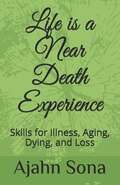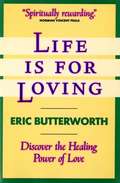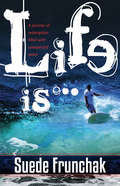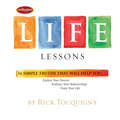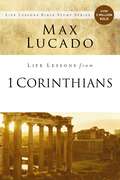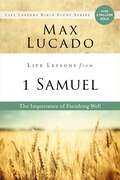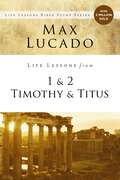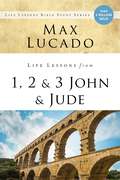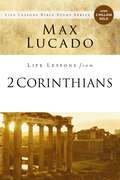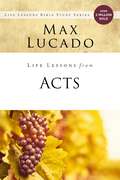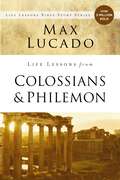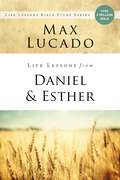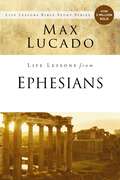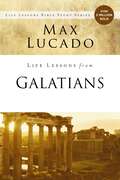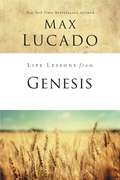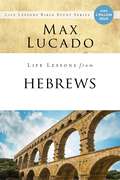- Table View
- List View
Life Is a Miracle: An Essay Against Modern Superstition
by Wendell Berry[A] scathing assessment . . . Berry shows that Wilson's much-celebrated, controversial pleas in Consilience to unify all branches of knowledge is nothing more than a fatuous subordination of religion, art, and everything else that is good to science . . . Berry is one of the most perceptive critics of American society writing today. The Washington Post€œI am tempted to say he understands [Consilience] better than Wilson himself . . . A new emancipation proclamation in which he speaks again and again about how to defy the tyranny of scientific materialism.The Christian Science MonitorIn Life Is a Miracle, the devotion of science to the quantitative and reductionist world is measured against the mysterious, qualitative suggestions of religion and art. Berry sees life as the collision of these separate forces, but without all three in the mix we are left at sea in the world.
Life Is a Near Death Experience: Skills for Illness, Aging, Dying, and Loss
by Ajahn Sona“I have this saying: ‘Don’t worry, everything is out of control.’ Once you really and truly get that, you will stop worrying, you will stop being fearful, because those negative feelings won’t change the existential situation we are all in.” Life is a Near Death Experience focuses primarily on illness and a handful of skillful ways to reduce the emotional suffering that can occur in its presence. <p><p>In these pages you will learn healthy, mindful choices about how to react to illness, and the prospect of death. The last section of the book gives a Buddhist context for the larger view of reality. If the first section helps you, that is all that matters. If you are curious about the Buddhist view of life, the second section may aid you as well. <p><p>Ajahn Sona is the Abbot of Birken Forest Buddhist Monastery (Pali name: ‘Sitavana’) located in British Columbia, Canada, and the author of Bloom: Buddhist Reflections on Serenity and Love.
Life Is a Soap Bubble: 100 Ways to Look at Life
by Osho Osho International FoundationRarely are written statements available from enlightened masters or mystics. Lao Tzu's statements of the Tao Te Ching came into being only at the end of his life. <P><P>Mystics usually don't write books; they speak and work directly with people in a transformational way. In the same way, Osho's books are transcriptions of his daily talks.This book is a rare exception: 100 letters written by Osho and mailed to a disciple, Yoga Sohan, in connection with events during a meditation camp in which she participated. Osho promised her that he would send her a letter every day...and that she should keep them so they could be published one day. This unique selection of these letters contains Osho's very personal instructions and insights on a meditative life. In one he says, "That's what meditation is all about - writing love letters to life."If you have come to the point where you feel there must be something more to life and are ready to explore other dimensions of being, this collection will provide an essential road map. The one hundred short passages in this book are full of diverse and pertinent gems. They will touch your heart and inspire you, showing you how to turn each and every moment of your life into a celebration.
Life Is a Zoo - No Matter What Side of the Cage You're On
by Gary RichmondGary Richmond tells the comical and hair-raising adventures of his own journey into manhood. Tales portray a young who tested every law of God and nature. He inspired teachers to retire early, his father to lay down the law, his mother to throw up her hands, and his friends to risk their lives. But underneath the antics emerges a young man who grappled with his rocky passage into adulthood.
Life Is for Loving
by Eric ButterworthThe word "love" may have become a cliche, but in Life is for Loving, Eric Butterworth maintains that love is vital, cosmic energy flowing through us all. Life is not for existing or "making do," but for loving, and Butterworth shows us how we are to find love in all aspects of life-marriage, sexuality, work, spirituality, and more. Making use of personal experiences, the insights of philosophers and poets, and the cumulative wisdom of the ages, Butterworth convinces us that love is the key to life, and that life-all of it-is for loving.
Life Is...: A Journey of Redemption Filled With Unexpected Grace
by Suede FrunchakYouth and young adults struggling with substance abuse, correctional circumstances, addictions, or just life itself can find freedom in this open, honest testimonial of recovery from drugs and alcohol! A true story of redemption through a higher power, Life Is…shares the author&’s downfall into addiction and lessons experienced in his own passage from drug addiction. The author&’s testimony gives the reader insight to change negative circumstances that have been passed down from generation to generation. The account of Suede Frunchak&’s journey through struggles and life lessons propels the reader into a state of hope and self-assurance. Life Is… is a clear translation of divine, forthright, standing courage, and biblical truth.
Life Lessons
by Rick TocquignyLife brings successes and failures, joys and adversity, to each of us. It's what you do with these experiences that shapes the person you become. Through true stories, readers will discover sixteen simple life lessons that will motivate and inspire. These simple truths will: make decision-making simpler; provide courage to pursue passions; give eyes to see new opportunities; offer tools to conquer challenges; and equip with the ability to find joy in each moment.Author, blog-talk radio host, and renowned speaker Rick Tocquigny delivers truly motivational messages tailored to help people overcome life's discouragements and find the blessing in each day. Tocquigny's message is infused with grace, joy, and faith.
Life Lessons and Love Languages: The Unexpected Journey of Dr. Gary Chapman
by Gary ChapmanGet to know the man behind the 5 Love Languages®. You just might discover yourself along the way.Many people are familiar with Dr. Gary Chapman, author of The 5 Love Languages®. Millions have been transformed by this New York Times bestselling book. But as influential as Gary has been, the surprising thing is . . . he&’s just a regular guy, not much different than you and me. And in the mirror of his life, you might discover your own story, too.In Life Lessons and Love Languages, you&’ll look behind the curtain for a glimpse of Gary&’s life, from his upbringing in Small Town, USA to becoming a bestselling author and international speaker. What makes him tick may surprise you! In Gary&’s story, you&’ll discover five great influences that shaped his, and most of our lives: home, education, marriage, children, and vocation. Even if you don&’t experience each influence yourself, you&’ll benefit from seeing how these pillars of human society work together to form productive individuals. Getting to know Gary will be a lot of fun. But getting to know yourself and how the world works is a gift that this small-town kid doesn&’t want you to miss.
Life Lessons and Love Languages: The Unexpected Journey of Dr. Gary Chapman
by Gary ChapmanGet to know the man behind the 5 Love Languages®. You just might discover yourself along the way.Many people are familiar with Dr. Gary Chapman, author of The 5 Love Languages®. Millions have been transformed by this New York Times bestselling book. But as influential as Gary has been, the surprising thing is . . . he&’s just a regular guy, not much different than you and me. And in the mirror of his life, you might discover your own story, too.In Life Lessons and Love Languages, you&’ll look behind the curtain for a glimpse of Gary&’s life, from his upbringing in Small Town, USA to becoming a bestselling author and international speaker. What makes him tick may surprise you! In Gary&’s story, you&’ll discover five great influences that shaped his, and most of our lives: home, education, marriage, children, and vocation. Even if you don&’t experience each influence yourself, you&’ll benefit from seeing how these pillars of human society work together to form productive individuals. Getting to know Gary will be a lot of fun. But getting to know yourself and how the world works is a gift that this small-town kid doesn&’t want you to miss.
Life Lessons for Mastering the Law of Attraction: Essential Ingredients for Living a Prosperous Life
by Jack Canfield Mark Victor Hansen Jeanna Gabellini Eva GregoryDefining moments in life, creating space to create prosperity, acting 'as if,' trusting in intuition, transforming thought, having an 'attitude of gratitude,' and changing the impossible to possible.
Life Lessons from 1 Corinthians: A Spiritual Health Check-Up (Life Lessons)
by Max LucadoOVER 2 MILLION SOLD IN THE LIFE LESSONS SERIES!The book of 1 Corinthians is more than a list of sins—though many sins are mentioned—it's an epistle of patience. The Christians in Corinth were falling all over themselves for sin, and yet Paul calls them "brothers and sisters" first. Paul is angry but driven by love and eager to talk about the God of second chances.Paul's letter confronts us today who need a spiritual check-up. Just as they were intended to do for the Corinthians, his words encourage us and show us how to lead a pure life. As you read, study, journal, and discuss the book of 1 Corinthians, watch for these key themes that Max will unpack throughout the book:The church, as the body of Christ, should be unified in the same way a physical body is united.God calls His people to sexual purity.We must honor God within our human relationships.Love is the greatest of all gifts. The Life Lessons with Max Lucado series brings the Bible to life in twelve lessons filled with intriguing questions, inspirational stories, and poignant reflections to take you deeper into God's Word. Each lesson includes:An opening reflection on the Bible book you're studying.Background information to deepen your understanding of the cultural and historical setting.An excerpt of the text (from the NIV and the NKJV).Exploration questions with plenty of room to write your own thoughts and notes.Inspirational thoughts from Max as well as a closing takeaway for further reflection. The Life Lessons series is ideal for use in both a small-group setting or for individual study.
Life Lessons from 1 Samuel: The Importance of Finishing Well (Life Lessons)
by Max LucadoIt matters how you finish.A good start is crucial, but it's the end that matters. First Samuel is a book of good starts but bad finishes. Eli was a sterling religious leader, but by the end of his life, the ark of the covenant had been captured and his two rebellious sons killed. Samuel was a prophet of God who anointed kings, but his sons also turned away from the Lord. The most dramatic example is Saul. He seemed to be the perfect choice for Israel's first king. But success led to disobedience, and he slid from prominence to paranoia to suicide. These stories remind us that when it comes to our faith, we also need to finish well. As the apostle Paul wrote, we must "run in such a way as to get the prize" (1 Corinthians 9:24).The Life Lessons with Max Lucado series brings the Bible to life in twelve lessons filled with intriguing questions, inspirational stories, and poignant reflections to take you deeper into God's Word. Each lesson includes an opening reflection, background information, an excerpt of the text (from the New International and New King James versions), exploration questions, inspirational thoughts from Max, and a closing takeaway for further reflection. The Life Lessons series is ideal for use in both a small-group setting and for individual study.
Life Lessons from 1 and 2 Peter: Between the Rock and a Hard Place (Life Lessons)
by Max LucadoOVER 2 MILLION SOLD IN THE LIFE LESSONS SERIES!Has your peace been stolen? Dreams crushed? Hope lost? Life has a way of not turning out the way we want.The disciple Peter knew what it was like to go through tough times. He endured threats, punishment, time in jail, beatings, and false words. He had seen enough to know how to stay strong in tough times. So he wrote a survival manual to show how we should act and respond when life isn&’t fair. His words of wisdom are beacons of hope for making it through hard times. Peter&’s counsel may surprise you. But it may be just what you need to sustain you when you find that you are between a rock and a hard place.As you read, study, journal, and discuss the books of Peter, watch for these key themes that Max will unpack throughout the book:Our richest inheritance is not in this world—it waits in heaven.It is up to each Christian to remain pure.It is an honor to suffer for Christ.Satan fights against the growth and victory of believers. The Life Lessons with Max Lucado series brings the Bible to life in twelve lessons filled with intriguing questions, inspirational stories, and poignant reflections to take you deeper into God's Word. Each lesson includes:An opening reflection on the Bible book you're studying.Background information to deepen your understanding of the cultural and historical setting.An excerpt of the text (from the NIV and the NKJV).Exploration questions with plenty of room to write your own thoughts and notes.Inspirational thoughts from Max as well as a closing takeaway for further reflection. The Life Lessons series is ideal for use in both a small-group setting or for individual study.
Life Lessons from 1 and 2 Thessalonians: Transcendent Living in a Transient World (Life Lessons)
by Max LucadoOVER 2 MILLION SOLD IN THE LIFE LESSONS SERIES!The church in Thessalonica was a study in contrast. They had been a quiet and holy people. But after a while, they had become restless and impatient. They needed direction on how to live. So Paul wrote the young church two letters. The first commended the believers for their faith and encouraged them to continue living according to the gospel principles he had taught. The second letter was filled with helpful hints that corrected their wrong beliefs, assumptions, and behaviors. Whether we are living a quiet and holy life or one that leaves us restless and impatient, Paul's letters encourage us. They challenge us to remain faithful in a temporary world.As you read, study, journal, and discuss the books of 1 and 2 Thessalonians, watch for these key themes that Max will unpack throughout the book:We should live in preparation for Christ's return.God wants holy and pure worship.The time of Christ's return will be unpredictable.How we live our everyday lives, matters. The Life Lessons with Max Lucado series brings the Bible to life in twelve lessons filled with intriguing questions, inspirational stories, and poignant reflections to take you deeper into God's Word. Each lesson includes:An opening reflection on the Bible book you're studying.Background information to deepen your understanding of the cultural and historical setting.An excerpt of the text (from the NIV and the NKJV).Exploration questions with plenty of room to write your own thoughts and notes.Inspirational thoughts from Max as well as a closing takeaway for further reflection. The Life Lessons series is ideal for use in both a small-group setting or for individual study.
Life Lessons from 1 and 2 Timothy and Titus: Ageless Wisdom for Young Leaders (Life Lessons)
by Max LucadoOVER 2 MILLION SOLD IN THE LIFE LESSONS SERIES!Who is a mentor in your life? Who guides you through the ups and downs, helps you make decisions, is there when you have questions and doubts?The apostle Paul knew the importance of this kind of discipleship. He mentored Timothy, a young pastor who was facing all sorts of challenges. He also pointed the way for Titus, a pastor who was shaping an early church. Paul's letters to these young leaders are packed with instruction, guidelines, principles, and encouragement. His practical words of wisdom are valuable keys to discipleship in any generation.As you read, study, journal, and discuss the books of 1 and 2 Timothy and Titus, watch for these key themes that Max will unpack throughout the book:Jesus Christ is the center of the gospel.The faith held by the church should be manifested in the behavior of the church.Church leaders are expected to live above reproach.There is accountability among the church body. The Life Lessons with Max Lucado series brings the Bible to life in twelve lessons filled with intriguing questions, inspirational stories, and poignant reflections to take you deeper into God's Word. Each lesson includes:An opening reflection on the Bible book you're studying.Background information to deepen your understanding of the cultural and historical setting.An excerpt of the text (from the NIV and the NKJV).Exploration questions with plenty of room to write your own thoughts and notes.Inspirational thoughts from Max as well as a closing takeaway for further reflection. The Life Lessons series is ideal for use in both a small-group setting or for individual study.
Life Lessons from 1, 2, 3 John and Jude: Living and Loving by Truth (Life Lessons)
by Max LucadoOVER 2 MILLION SOLD IN THE LIFE LESSONS SERIES!What inspires you? A personal motto? A quote that directs your daily life? The letters written by the apostle John and Jude focused on two simple words that define our life and permeate our actions: love and truth.These letters are full of insights and direction along with warnings and encouragement . . . all based on these two words. These words remind us that God supplies all we need. That there is a real purpose to generosity. That there are times to be tolerant and times to take a stand. That faith includes certainties. Love and truth remind us of the life-changing power in the gospel message. Want a guide to how to live? Study John and Jude's letters of love and truth.As you read, study, journal, and discuss the books of John and Jude, watch for these key themes that Max will unpack throughout the book:Our obedience in faith keeps us in fellowship with God.God will forgive our sins.We can measure any truth by where it places Jesus in relation to God.God's love and Christ's victory are the Christian's inheritance. The Life Lessons with Max Lucado series brings the Bible to life in twelve lessons filled with intriguing questions, inspirational stories, and poignant reflections to take you deeper into God's Word. Each lesson includes:An opening reflection on the Bible book you're studying.Background information to deepen your understanding of the cultural and historical setting.An excerpt of the text (from the NIV and the NKJV).Exploration questions with plenty of room to write your own thoughts and notes.Inspirational thoughts from Max as well as a closing takeaway for further reflection. The Life Lessons series is ideal for use in both a small-group setting or for individual study.
Life Lessons from 2 Corinthians: Remembering What Matters (Life Lessons)
by Max LucadoOVER 2 MILLION SOLD IN THE LIFE LESSONS SERIES!Some days we just forget. We forget the house keys. We forget the directions. We forget to return a friend's phone call. And sometimes, we forget that we belong to Jesus. It's not intentional, but it happens.The church in Corinth had forgotten. They were divisive. Insensitive. Argumentative. Rebellious. They listened to false teachers who questioned the message of Christ and who accused Paul of being unreliable and a false apostle. Paul knew the Corinthian church needed a reminder, so he wrote a heartfelt letter defending his character, ministry, and message. The letter reminds the Corinthians to turn from their worldly ways and to think and live in ways that honor God. Likewise, Paul&’s letter encourages us to look at our own lives so we won&’t forget what really matters.As you read, study, journal, and discuss the book of 2 Corinthians, watch for these key themes that Max will unpack throughout the book:Faith in Christ brings new life.God's people should give of their income to support God's work in the world.God can work through us no matter who we are. The Life Lessons with Max Lucado series brings the Bible to life in twelve lessons filled with intriguing questions, inspirational stories, and poignant reflections to take you deeper into God's Word. Each lesson includes:An opening reflection on the Bible book you're studying.Background information to deepen your understanding of the cultural and historical setting.An excerpt of the text (from the NIV and the NKJV).Exploration questions with plenty of room to write your own thoughts and notes.Inspirational thoughts from Max as well as a closing takeaway for further reflection. The Life Lessons series is ideal for use in both a small-group setting or for individual study.
Life Lessons from Acts: Christ's Church in the World (Life Lessons)
by Max LucadoOVER 2 MILLION SOLD IN THE LIFE LESSONS SERIES!As you read the book of Acts, you may wonder: are these the same disciples I read about in the gospels? The ones who doubted in Galilee and ran for their lives in Gethsemane? The answer is: no. They are different. The Spirit dwells within them. And what God did for them, he longs to do for you.Join beloved author Max Lucado as he walks the roads of Acts—the amazing account of God's active Spirit among his servants and Christ's Church spreading to the world. As you read, study, journal, and discuss the book of Acts, watch for these key themes that Max will unpack throughout the book:The foundations of the early church established in the aftermath of Jesus' resurrection and ascension.The Holy Spirit empowered the disciples to spread the gospel into the world as Jesus commanded.The first struggle of the gospel was to stand independently of Jewish tradition and faith.The sacrifice Jesus made was for all people. The Life Lessons with Max Lucado series brings the Bible to life in twelve lessons filled with intriguing questions, inspirational stories, and poignant reflections to take you deeper into God's Word. Each lesson includes:An opening reflection on the Bible book you're studying.Background information to deepen your understanding of the cultural and historical setting.An excerpt of the text (from the NIV and the NKJV).Exploration questions with plenty of room to write your own thoughts and notes.Inspirational thoughts from Max as well as a closing takeaway for further reflection. The Life Lessons series is ideal for use in both a small-group setting or for individual study.
Life Lessons from Colossians and Philemon: The Difference Christ Makes (Life Lessons)
by Max LucadoOVER 2 MILLION SOLD IN THE LIFE LESSONS SERIES!Do you remember when God amazed you? When he marvelously provided for you? Sadly, sometimes we forget God's mercy.The early believers in the Colossian church had forgotten too. Instead, they were impressed by spiritual claims from false teachers. The apostle Paul's letters reminded them that Jesus is all we will ever need. Paul encourages. He challenges. He gives principles for living and interacting at work, in our families, and our churches. Paul also knew that one of his friends had been betrayed and had every reason to seek revenge. So Paul wrote to Philemon encouraging him to rise above his hurt and show mercy, forgiveness, grace, and love. Paul's letters remind us of the difference Christ makes in every aspect of our lives.As you read, study, journal, and discuss the books of Colossians and Philemon, watch for these key themes that Max will unpack throughout the book:Faith, love, and hope are key to following Christ.In Christ Jesus, we have been offered freedom.Because of Jesus, Christians can be as in touch with the next world as this one. The Life Lessons with Max Lucado series brings the Bible to life in twelve lessons filled with intriguing questions, inspirational stories, and poignant reflections to take you deeper into God's Word. Each lesson includes:An opening reflection on the Bible book you're studying.Background information to deepen your understanding of the cultural and historical setting.An excerpt of the text (from the NIV and the NKJV).Exploration questions with plenty of room to write your own thoughts and notes.Inspirational thoughts from Max as well as a closing takeaway for further reflection. The Life Lessons series is ideal for use in both a small-group setting or for individual study.
Life Lessons from Daniel and Esther: Faith Under Pressure (Life Lessons)
by Max LucadoOVER 2 MILLION SOLD IN THE LIFE LESSONS SERIES!Staying faithful when the pressure was most intense. That&’s what these two did.The Jewish people had reason to be depressed. Their nation had been conquered. Their hometown was in ruins. They were living in captivity. Yet from the ashes, God raised up two key figures to preserve the Jewish race.Daniel was among the first of the captives carried away by the Babylonians. Although he lived in a culture opposed to God, he was always faithful to the Lord – even in the face of death – and ultimately was able to influence kings and rulers. Esther was in exile during the time of the Persian Empire. Like Daniel, the Lord also placed her in a position to influence those in power. God also called her to step out in faith and risk her life to foil a plot against her people. As a result of her bold actions, the entire Jewish race was saved from annihilation.As you read, study, journal, and discuss the books of Daniel and Esther, watch for these key themes that Max will unpack throughout the book:God leads in our lives even in difficult circumstances.Sometimes faithfulness is rewarded by miracles.God will be faithful to his people in the future as he has in the past. The Life Lessons with Max Lucado series brings the Bible to life in twelve lessons filled with intriguing questions, inspirational stories, and poignant reflections to take you deeper into God's Word. Each lesson includes:An opening reflection on the Bible book you&’re studying.Background information to deepen your understanding of the cultural and historical setting.An excerpt of the text (from the NIV and the NKJV).Exploration questions with plenty of room to write your own thoughts and notes.Inspirational thoughts from Max as well as a closing takeaway for further reflection. The Life Lessons series is ideal for use in both a small-group setting or for individual study.
Life Lessons from Ephesians: Where You Belong (Life Lessons)
by Max LucadoOVER 2 MILLION SOLD IN THE LIFE LESSONS SERIES!Is there anything more elegant than a wedding? Candles bathe a chapel in gold. Groomsmen and bridesmaids descend the aisles with bouquets of newness. And the groom stands at the front, longing for that moment his bride will appear and step toward him to start their new life together.In Ephesians, Paul reminds us that Jesus is also longing for the day he will be united with the church—his bride in all her beauty. Paul's letter celebrates the beauty of the church and gives us wonderful examples and overviews of a Christian life. Paul shows us how to walk worthy of Christ as we live our life for God. His focus on the beauty of the church reminds us that through salvation we become a part of God's family: a place where we can experience true belonging.As you read, study, journal, and discuss the book of Ephesians, watch for these key themes that Max will unpack throughout the book:We have many spiritual blessings through Christ.Each believer is gifted through the Spirit of God.Our faith should work its way into all of our relationships.Our spiritual strength comes from God through his Word and our faith. The Life Lessons with Max Lucado series brings the Bible to life in twelve lessons filled with intriguing questions, inspirational stories, and poignant reflections to take you deeper into God's Word. Each lesson includes:An opening reflection on the Bible book you're studying.Background information to deepen your understanding of the cultural and historical setting.An excerpt of the text (from the NIV and the NKJV).Exploration questions with plenty of room to write your own thoughts and notes.Inspirational thoughts from Max as well as a closing takeaway for further reflection. The Life Lessons series is ideal for use in both a small-group setting or for individual study.
Life Lessons from Ezra and Nehemiah: Lessons in Leadership (Life Lessons)
by Max LucadoOVER 2 MILLION SOLD IN THE LIFE LESSONS SERIES!Two leaders, one burning mission: restoration.When the people of Israel returned to Jerusalem after their exile in Babylon, they found the city laid waste, the temple destroyed, and their way of life obliterated. Out of the ashes of this devastation, two leaders emerged to restore the foundations of their worship and their city.Ezra, the first to return, set out to restore true worship in Jerusalem by reminding the people of God&’s teaching, what it meant for them, and how it should shape their lives. Nehemiah, the next to arrive, exchanged his royal cupbearer's robes for coveralls and got to work rebuilding the wall. The project took twelve years and was an uphill battle all the way. The efforts of these men reveal just how much God can accomplish in our lives when we follow where he leads.As you read, study, journal, and discuss the books of Ezra and Nehemiah, watch for these key themes that Max will unpack throughout the book:When the Hebrews were allowed to return home their spiritual restoration was as important as their national restoration.Restoring the temple was a significant step in the spiritual restoration of the people.The idolatry of the Hebrews was rooted in foreign wives who continued to worship their false gods. This is why the men were asked to divorce their foreign wives. The Life Lessons with Max Lucado series brings the Bible to life in twelve lessons filled with intriguing questions, inspirational stories, and poignant reflections to take you deeper into God's Word. Each lesson includes:An opening reflection on the Bible book you're studying.Background information to deepen your understanding of the cultural and historical setting.An excerpt of the text (from the NIV and the NKJV).Exploration questions with plenty of room to write your own thoughts and notes.Inspirational thoughts from Max as well as a closing takeaway for further reflection. The Life Lessons series is ideal for use in both a small-group setting or for individual study.
Life Lessons from Galatians: Free in Christ (Life Lessons)
by Max LucadoOVER 2 MILLION SOLD IN THE LIFE LESSONS SERIES!Whose approval do you hope to win? Friends? Coworkers? Someone in your family? What about God? Do you sometimes wonder if you need to do more to earn his approval?Religious teachers in the early church were insisting that faith was not enough, that being right with God required something more. Early Christians were almost ready to accept and follow these extra requirements. This disturbed the apostle Paul. So he reminded the believers that salvation isn't based on following a religious code. Nor is it based on what we do (or don't do) or what we know or feel. Nothing is required on our part, except to believe. In showing us the profound difference between living by law and living by grace, he reminds us that we are indeed free in Christ.As you read, study, journal, and discuss the book of Galatians, watch for these key themes that Max will unpack throughout the book:Salvation comes by grace, not works.We should bear the fruit of the Holy Spirit in our lives.We will reap in life what we have sown in life. The Life Lessons with Max Lucado series brings the Bible to life in twelve lessons filled with intriguing questions, inspirational stories, and poignant reflections to take you deeper into God's Word. Each lesson includes:An opening reflection on the Bible book you're studying.Background information to deepen your understanding of the cultural and historical setting.An excerpt of the text (from the NIV and the NKJV).Exploration questions with plenty of room to write your own thoughts and notes.Inspirational thoughts from Max as well as a closing takeaway for further reflection. The Life Lessons series is ideal for use in both a small-group setting or for individual study.
Life Lessons from Genesis: Book of Beginnings (Life Lessons)
by Max LucadoA beginning. An origin. A foundation.Knowing where we came from says much about where we are going. Perhaps that is why the first book of the Bible is a book of beginnings. God wants us to know where we came from. Learning that will teach us much about the place we are going. The book of Genesis brings us back to the beginning of the Bible, where the foundation of life itself is explained. We learn how we were created, about the origins of sin and its fallout, and how to best relate to God – through obedience and trust. We are drawn into tales of deceit, jealousy, and outright failure, where we see how God still uses flawed people. And weaving throughout these earliest stories of humankind are the golden threads of God’s promises – promises we can trace from their origins, through the course of history, up through our lives today, and beyond us to the end of time when his final promises will at last be fulfilled.The Life Lessons with Max Lucado series brings the Bible to life in twelve lessons filled with intriguing questions, inspirational stories, and poignant reflections to take you deeper into God’s Word. Each lesson includes an opening reflection, background information, an excerpt of the text (from the New International and New King James versions), exploration questions, inspirational thoughts from Max, and a closing takeaway for further reflection. The Life Lessons series is ideal for use in both a small-group setting and for individual study.
Life Lessons from Hebrews: The Incomparable Christ (Life Lessons)
by Max LucadoOVER 2 MILLION SOLD IN THE LIFE LESSONS SERIES!The Jewish believers were torn between their new faith in Jesus and their old ways rooted in Old Testament routines and rituals. They were tempted to go back to their familiar life that seemed "good enough." But the author of Hebrews shows that when Jesus came, "the best got better."The unknown author of Hebrews skillfully compares these believers' old ways and their new faith, arguing that Christ is better in every way. He focuses on Jesus, his effective ministry, and his ultimate sacrifice, showing us that absolutely nothing compares to our incomparable Christ.As you read, study, journal, and discuss the book of Hebrews, watch for these key themes that Max will unpack throughout the book:Jesus Christ brought about a whole new way of connecting with and following God.Jesus is our compassionate high priest.Faith is the connector between this life and the next. The Life Lessons with Max Lucado series brings the Bible to life in twelve lessons filled with intriguing questions, inspirational stories, and poignant reflections to take you deeper into God's Word. Each lesson includes:An opening reflection on the Bible book you're studying.Background information to deepen your understanding of the cultural and historical setting.An excerpt of the text (from the NIV and the NKJV).Exploration questions with plenty of room to write your own thoughts and notes.Inspirational thoughts from Max as well as a closing takeaway for further reflection. The Life Lessons series is ideal for use in both a small-group setting or for individual study.

